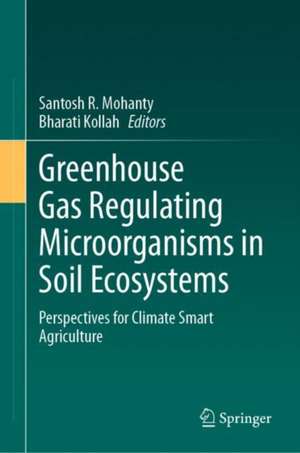Greenhouse Gas Regulating Microorganisms in Soil Ecosystems: Perspectives for Climate Smart Agriculture
Editat de Santosh Ranjan Mohanty, Bharati Kollahen Limba Engleză Hardback – 11 ian 2025
Preț: 854.54 lei
Preț vechi: 1124.40 lei
-24% Nou
Puncte Express: 1282
Preț estimativ în valută:
163.53€ • 169.76$ • 136.36£
163.53€ • 169.76$ • 136.36£
Carte tipărită la comandă
Livrare economică 19-25 martie
Preluare comenzi: 021 569.72.76
Specificații
ISBN-13: 9783031705687
ISBN-10: 3031705688
Ilustrații: X, 430 p. 36 illus., 32 illus. in color.
Dimensiuni: 155 x 235 mm
Ediția:2024
Editura: Springer International Publishing
Colecția Springer
Locul publicării:Cham, Switzerland
ISBN-10: 3031705688
Ilustrații: X, 430 p. 36 illus., 32 illus. in color.
Dimensiuni: 155 x 235 mm
Ediția:2024
Editura: Springer International Publishing
Colecția Springer
Locul publicării:Cham, Switzerland
Cuprins
1 Sources and Sinks of Greenhouse Gasses (GHG) in Agricultural Soil Ecosystem.- 2 Soil and Environmental Variables Influencing Greenhouse Gas Cycling in an Agroecosystem.- 3 Greenhouse Gas Cycling and Ecosystem Services.- 4 Greenhouse Gas Emission from Different Fertilizers (Organic, Inorganic and Integrated) Management Agroecosystems.- 5 Greenhouse Gas Emissions from Agroecosystems Under Conservation Agriculture.- 6 Factors Affecting Carbon Sequestration and Greenhouse Gas Emission in Agroecosystem.- 7 Prediction of Crop Response to Atmospheric Greenhouse Gas Concentration and Climate Parameters.- 8 Impact of Elevated CO2, and Temperature on Greenhouse Gas Emission and Decomposition.- 9 Carbon Speciation by Soil Microbes in Soil.- 10 The Nitrogen Cycle, and N2O Emission, and Its Decomposition Processes in Soil.- 11 Soil Ecosystem Services and the Greenhouse Gas Emission and Cycling.- 12 Diversity of Greenhouse Gas Producing and Mitigating Microbes in Soil.- 13 Strategies to Improve N Use Efficiency to Minimize N2O Emission from Agricultural Soil.- 14 Impact of Fertilizers on Greenhouse Gas Mitigating Microbes in Agroecosystem.- 15 Microbial Diversity Under Organic Fertilizer Management Systems and Identification of Best Fertilizer Practice.- 16 Climate Resilient Agriculture.- 17 Carbon Sequestration Strategies in Response to Fertilizer Application.- 18 Organic Farming.- 19 Long Term Fertilizer Experiments.- 20 Synthesis Report on Greenhouse Gas Emissions from Agroecosystems.
Notă biografică
Dr. Santosh Ranjan Mohanty is a Principal Scientist & Head of Department for Soil Biology Division at the Indian Institute of Soil Science, Bhopal, India.
Dr. Bharati Kollah is a Principal Scientist at the Indian Institute of Soil Science in Bhopal, India.
Dr. Bharati Kollah is a Principal Scientist at the Indian Institute of Soil Science in Bhopal, India.
Textul de pe ultima copertă
This volume comprehensively covers soil microbial processes that regulate the flux of greenhouse gasses (GHG) from agricultural soils, in an effort to address how GHG regulating microbes can be used to mitigate harmful climate change impacts on agriculture. The chapters define the linkages among soil microbial functioning, crop responses, ecosystem functioning, and GHG cycling processes. The book is framed through three major theme, including source and sink of GHG, microbial processes regulating GHG, and agricultural strategies and technologies to mitigate GHG emissions. The chapters highlight the fundamentals of soil microbial diversity and interactions with climate changing factors, soil carbon dynamics in response to different agricultural practices, conservation agriculture strategies to reduce GHG emissions from agriculture, and climate change mitigation through organic and climate-smart farming. The book is intended for policy makers, students, and researchers of environmental science, agriculture, soil science, and soil microbiology.
Caracteristici
Discusses soil microbial processes that regulate the flux of greenhouse gasses from agricultural soils Covers how soil can play a key role in the degradation of greenhouse gasses Explores agricultural technologies for improving soil carbon sequestration and agricultural conservation
